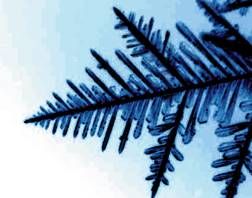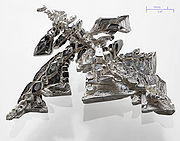.gif)
Dendrite (metal)
Encyclopedia


Metallurgy
Metallurgy is a domain of materials science that studies the physical and chemical behavior of metallic elements, their intermetallic compounds, and their mixtures, which are called alloys. It is also the technology of metals: the way in which science is applied to their practical use...
is a characteristic tree-like structure of crystal
Crystal
A crystal or crystalline solid is a solid material whose constituent atoms, molecules, or ions are arranged in an orderly repeating pattern extending in all three spatial dimensions. The scientific study of crystals and crystal formation is known as crystallography...
s growing as molten metal freezes, the shape produced by faster growth along energetically favourable crystallographic
Crystallography
Crystallography is the experimental science of the arrangement of atoms in solids. The word "crystallography" derives from the Greek words crystallon = cold drop / frozen drop, with its meaning extending to all solids with some degree of transparency, and grapho = write.Before the development of...
directions. This dendritic growth has large consequences in regards to material properties.
Dendrites form in unary (one-component) systems as well as multi-component systems. The requirement is that the liquid (the molten material) be undercooled, aka supercooled, below the freezing point of the solid. Initially, a spherical solid nucleus grows in the undercooled melt. As the sphere grows, the spherical morphology becomes unstable and its shape becomes perturbed. The solid shape begins to express the preferred growth directions of the crystal. This growth direction may be due to anisotropy in the surface energy of the solid–liquid interface, or to the ease of attachment of atoms to the interface on different crystallographic planes, or both (for an example of the latter, see hopper crystal
Hopper crystal
thumb|300px|right|Synthetic bismuth crystalA hopper crystal is a form of crystal, defined by its "hoppered" shape.The edges of hoppered crystals are fully developed, but the interior spaces are not filled in. This results in what appears to be a hollowed out step lattice formation, as if someone...
). In metallic systems, interface attachment kinetics is usually negligible (for non-negligible cases, see dendrite (crystal)
Dendrite (crystal)
A crystal dendrite is a crystal that develops with a typical multi-branching tree-like form. Dendritic crystal growth is very common and illustrated by snowflake formation and frost patterns on a window. Dendritic crystallization forms a natural fractal pattern...
). In metallic systems, the solid then attempts to minimize the area of those surfaces with the highest surface energy. The dendrite thus exhibits a sharper and sharper tip as it grows. If the anisotropy is large enough, the dendrite may present a faceted morphology. The microstructural length scale is determined by the interplay or balance between the surface energy and the temperature gradient (which drives the heat/solute diffusion) in the liquid at the interface.
As solidification proceeds, an increasing number of atoms lose their kinetic energy, making the process exothermic. For a pure material, latent heat is released at the solid–liquid interface so that the temperature remains constant until the melt has completely solidified. The growth rate of the resultant crystalline substance will depend on how fast this latent heat can be conducted away. A dendrite growing in an undercooled melt can be approximated as a parabolic needle-like crystal that grows in a shape-preserving manner at constant velocity. Nucleation and growth determine the grain size in equiaxed solidification while the competition between adjacent dendrites decides the primary spacing in columnar growth. Generally, if the melt is cooled slowly, nucleation of new crystals will be less than at large undercooling. The dendritic growth will result in dendrites of a large size. Conversely, a rapid cooling cycle with a large undercooling will increase the number of nuclei and thus reduce the size of the resulting dendrites (and often lead to small grains).
Smaller dendrites generally lead to higher ductility
Ductility
In materials science, ductility is a solid material's ability to deform under tensile stress; this is often characterized by the material's ability to be stretched into a wire. Malleability, a similar property, is a material's ability to deform under compressive stress; this is often characterized...
of the product. One application where dendritic growth and resulting material properties can be seen is the process of welding
Welding
Welding is a fabrication or sculptural process that joins materials, usually metals or thermoplastics, by causing coalescence. This is often done by melting the workpieces and adding a filler material to form a pool of molten material that cools to become a strong joint, with pressure sometimes...
. The dendrites are also common in cast
Casting
In metalworking, casting involves pouring liquid metal into a mold, which contains a hollow cavity of the desired shape, and then allowing it to cool and solidify. The solidified part is also known as a casting, which is ejected or broken out of the mold to complete the process...
products, where they may become visible by etching of a polished specimen.
As dendrites develop further into the liquid metal, they get hotter because they continue to extract heat. If they get too hot, they will remelt. This remelting of the dendrites is called recalescence.
Dendrites also form during the freezing of many nonmetallic substances such as ice
Ice
Ice is water frozen into the solid state. Usually ice is the phase known as ice Ih, which is the most abundant of the varying solid phases on the Earth's surface. It can appear transparent or opaque bluish-white color, depending on the presence of impurities or air inclusions...
.
Dendrites usually form under non-equilibrium conditions.
Common dendritic metal material is nickel carbonyl
Nickel carbonyl
Nickel carbonyl is the organonickel compound with the formula Ni4. This pale-yellow liquid is the principal carbonyl of nickel. It is an intermediate in the Mond process for the purification of nickel and a reagent in organometallic chemistry...
, where the particles have a classical "spiky" morphology.

